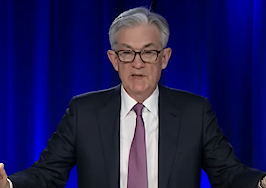Uncertainty over exactly how much of a threat the new Omicron coronavirus variant poses to human health and the global economy could keep the Federal Reserve from getting more aggressive about its timeline for withdrawing its support for mortgage markets when it meets next month.
The World Health Organization declared Omicron a “variant of concern” on Friday, sending long-term interest rates tumbling. Although interest rates held firm Monday, a surge in infections driven by the new variant could tame the appetite of the Fed and other central banks for monetary tightening.
Financial markets have already dialed back expectations that the Fed would quickly withdraw its support for mortgage markets and hike short terms rates three times next year. There’s also less certainty that the first increase in the federal funds rate will come in June.
Before news of Omicron broke, the CME FedWatch Tool on Nov. 22 showed markets pricing in expectations for three 0.25 percentage point increases in the federal funds rate next year, with a 77 percent expectation for at least one increase by June 2022.
The CME FedWatch Tool, which monitors futures contracts to calculate the probability of Fed rate hikes, showed markets on Monday now betting on just two increases in the federal funds rate next year, with a 64 percent chance of at least one increase by June.
The Fed is not expected to increase the short-term federal funds rate until it’s done tapering the $120 billion in monthly purchases of mortgage-backed securities and Treasurys it’s been making during the pandemic to keep long-term interest rates low.
The Fed began tapering those purchases by $15 billion a month in November, on a schedule that would have completed tapering by June.
Just last week, there was talk that the Federal Reserve might accelerate its tapering of support for mortgage markets because of concerns about inflation.
Minutes of the Federal Open Market Committee’s Nov. 3 meeting, released Wednesday, revealed that some policymakers are worried that the current plan to phase out the Fed’s asset purchases by June is too cautious.
The Fed had only committed to tapering for two months — November and December — reserving the right to adjust its plans as conditions warranted.
If the Omicron variant leads to new restrictions on business and travel that slow the pace of the U.S. economic recovery, the Fed might be less anxious about fighting inflation, and less inclined to accelerate tapering. That could take some of the pressure off of mortgage rates, which have been rising steadily since August as the economy recovers from the pandemic.
The Fed’s next meeting takes place over two days, beginning Dec. 14. Health experts say it will take at least a week or two before the threat posed by Omicron — including how easily it spreads, and how lethal it is — is better understood.
“If a clearer, and reasonably positive picture has not emerged by the time of the Dec. 14-to-15 meeting, then the Fed presumably will delay the decision to accelerate the pace of tapering,” said Pantheon Macroeconomics Chief Economist Ian Shepherdson, in a note to clients.
In the meantime, Shepherdson said, “the news probably will be dominated by the spread of the variant, further travel restrictions, and endless speculation about whether it evades vaccines. Covid-sensitive stocks in the travel and leisure sectors will be volatile, and probably have not yet bottomed, if we’re right in our view that the newsflow will get worse before it gets better.”
Europe “is already in the grip of a severe Delta Covid wave, thanks to relatively low total immunity rates,” Shephardson said. Although vaccination rates are high in most countries, immunity from prior infection is lower, and boosters have been rolled out more slowly.
So the rapid spread of Omicron “would make a bad situation worse,” Shepherdson warned.
Daily changes in 30-year fixed-rate mortgage rates
Yields on 10-year Treasurys — considered a barometer of where mortgage rates are headed — hit a peak of 1.69 percent last week on Wednesday, Nov. 24. After news of the Omicron variant broke, 10-year yields plunged below 1.50 percent on Friday, closing at 1.48 percent. Yields on 10-year Treasurys rebounded Monday to as high as 1.56 percent.
Get Inman’s Extra Credit Newsletter delivered right to your inbox. A weekly roundup of all the biggest news in the world of mortgages and closings delivered every Wednesday. Click here to subscribe.






